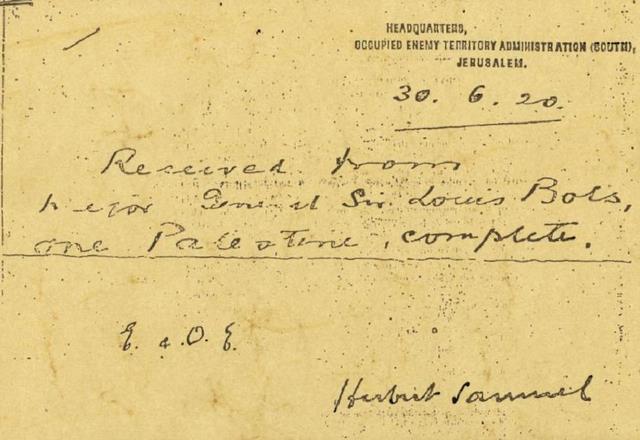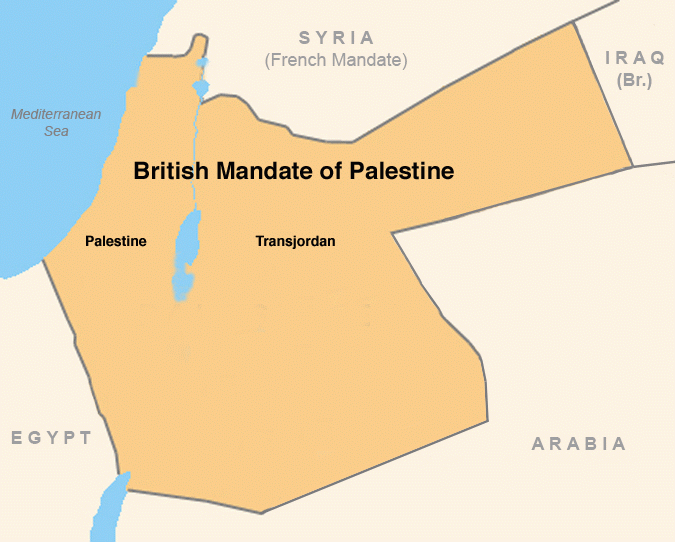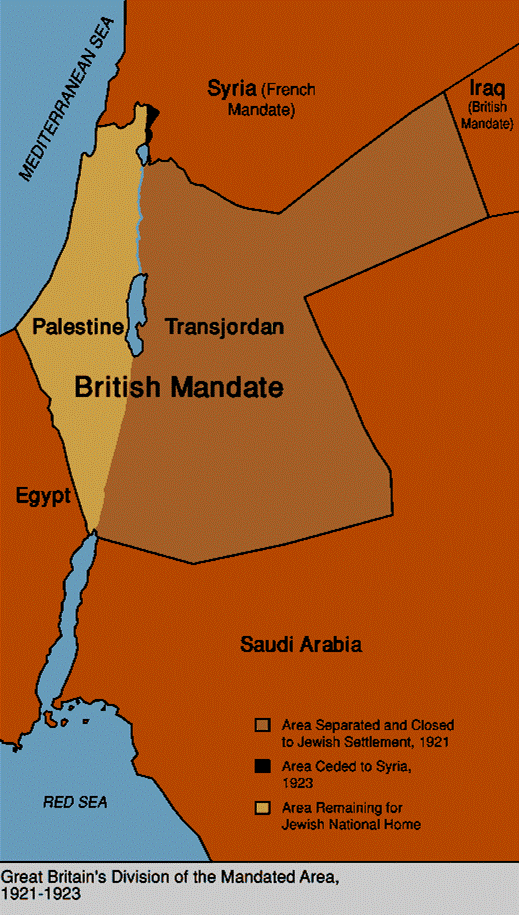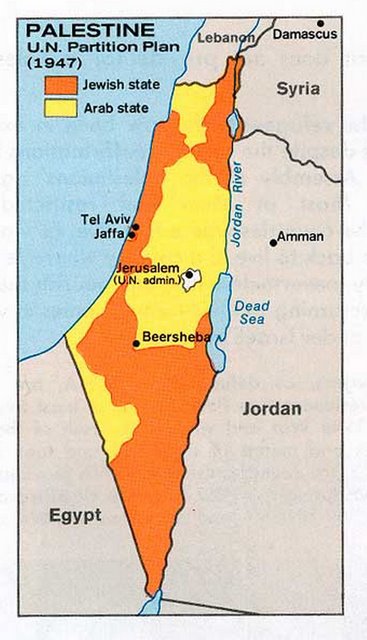The British Mandate of Palestine as defined by the League of Nations was a large territory covering 118,000 square kilometers. Before taking over the Mandate, the British siphoned off about 78% of the territory to form Transjordan under King Abdullah. The United Nations Partition Plan of 1947 further whittled down the Jewish State by dividing the territory of Palestine into a Jewish State and an Arab state. The outcome of the 1948 War of Independence gave Israel the territory which had been assigned to the Arabs. Later wars further enlarged Israel’s borders, although the territory east of the Jordan River became the independent state of Jordan and never became part of Israel.
The Sykes-Picot Agreement, 1916.
It is accordingly understood between the french and British governments-
That France and great Britain are prepared to recognize and protect an independent Arab states or a confederation of Arab states (a) and (b) marked on the annexed map, under the suzerainty of an Arab chief. That in area (a) France, and in area (b) great Britain, shall have priority of right of enterprise and local loans. That in area (a) France, and in area (b) great Britain, shall alone supply advisers or foreign functionaries at the request of the Arab state or confederation of Arab states.
That in the blue area France, and in the red area great Britain, shall be allowed to establish such direct or indirect administration or control as they desire and as they may think fit to arrange with the Arab state or confederation of Arab states.
That in the brown area there shall be established an international administration, the form of which is to be decided upon after consultation with Russia, and subsequently in consultation with the other allies, and the representatives of the sheriff of mecca.
That great Britain be accorded (1) the ports of Haifa and acre, (2) guarantee of a given supply of water from the tigres and euphrates in area (a) for area (b). His majesty’s government, on their part, undertake that they will at no time enter into negotiations for the cession of Cyprus to any third power without the previous consent of the french government.
That Alexandretta shall be a free port as regards the trade of the British empire, and that there shall be no discrimination in port charges or facilities as regards British shipping and British goods; that there shall be freedom of transit for British goods through Alexandretta and by railway through the blue area, or (b) area, or area (a); and there shall be no discrimination, direct or indirect, against British goods on any railway or against British goods or ships at any port serving the areas mentioned.
That Haifa shall be a free port as regards the trade of France, her dominions and protectorates, and there shall be no discrimination in port charges or facilities as regards french shipping and french goods. There shall be freedom of transit for french goods through Haifa and by the British railway through the brown area, whether those goods are intended for or originate in the blue area, area (a), or area (b), and there shall be no discrimination, direct or indirect, against french goods on any railway, or against french goods or ships at any port serving the areas mentioned.
That in area (a) the Baghdad railway shall not be extended southwards beyond Mosul, and in area (b) northwards beyond Samarra, until a railway connecting Baghdad and aleppo via the euphrates valley has been completed, and then only with the concurrence of the two governments.
That great Britain has the right to build, administer, and be sole owner of a railway connecting Haifa with area (b), and shall have a perpetual right to transport troops along such a line at all times. It is to be understood by both governments that this railway is to facilitate the connection of Baghdad with Haifa by rail, and it is further understood that, if the engineering difficulties and expense entailed by keeping this connecting line in the brown area only make the project unfeasible, that the french government shall be prepared to consider that the line in question may also traverse the Polgon Banias Keis Marib Salkhad tell Otsda Mesmie before reaching area (b).
Herbert Samuel Signs for Palestine, June 30, 1920.
British Mandate in Palestine, 1920 (as determined at the San Remo conference)
Winston Churchill on the Division of Palestine, Cairo Conference, Mar. 1921
I created Transjordan with the stroke of a pen on a Sunday afternoon in Cairo.
Quoted in Collins, L. & Lapierre, D. (1972). O Jerusalem! Simon & Schuster- New York.
About 78% of the British Mandate was siphoned off to create Transjordan.
Herbert Samuel objected to the creation of Transjordan
Samuel strongly disagreed with Churchill’s growing idea that a separate Transjordanian state should be created for Abdullah, who was in Amman waiting to plot his next move. When the Palestinian Political and Military Committee met for the first time on 17 March, Samuel rapidly found himself isolated in his view, and Churchill told him that the decision to create a Transjordanian state had already been made in London, albeit “a view arrived at after considerable discussion,” Samuel was faced with an effective fait accompli. Nonetheless, he did his best. As he was able to remind Churchill and the others, the area had been one included in the specifically part of the League of Nations mandate. If separated, it would be seen “as an independent Arab state.” Should Abdullah become its ruler, he would not only use his new domain to attack the French in Syria, but he would also create a major source of anti-Zionist feeling “and thus prove a danger.” With what we now call massive understatement, there was, warned Sir Herbert, “some probability of controversy in Palestine for some years on the question of Zionism”…
Christopher Catherwood, Churchill’s Folly, Carroll & Graf, New York 2004. p.140-141.
League of Nations Mandate for Palestine, July 24, 1922.
The Council of the League of Nations-
Whereas the Principal Allied Powers have agreed, for the purpose of giving effect to the provisions of Article 22 of the Covenant of the League of Nations, to entrust to a Mandatory selected by the said Powers the administration of the territory of Palestine, which formerly belonged to the Turkish Empire, within such boundaries as may be fixed by them; and
Whereas the Principal Allied Powers have also agreed that the Mandatory should be responsible for putting into effect the declaration originally made on November 2nd, 1917, by the Government of His Britannic Majesty, and adopted by the said Powers, in favor of the establishment in Palestine of a national home for the Jewish people, it being clearly understood that nothing should be done which might prejudice the civil and religious rights of existing non-Jewish communities in Palestine, or the rights and political status enjoyed by Jews in any other country…
ART. 25.
In the territories lying between the Jordan and the eastern boundary of Palestine as ultimately determined, the Mandatory shall be entitled, with the consent of the Council of the League of Nations, to postpone or withhold application of such provisions of this mandate as he may consider inapplicable to the existing local conditions, and to make such provision for the administration of the territories as he may consider suitable to those conditions, provided that no action shall be taken which is inconsistent with the provisions of Articles 15, 16 and 18.
Britain formally recognized the Emirate of Transjordan as a state under the leadership of Emir Abdullah, May 15, 1923.
Abdullah negotiated a new Anglo-Transjordanian treaty, ending the British mandate and gaining full independence for Transjordan although Britain still had some economic control – March 22, 1946.
United Nations General Assembly Resolution 181, Nov. 29, 1947.
A. TERMINATION OF MANDATE, PARTITION AND INDEPENDENCE
The Mandate for Palestine shall terminate as soon as possible but in any case not later than 1 August 1948.
The armed forces of the mandatory Power shall be progressively withdrawn from Palestine, the withdrawal to be completed as soon as possible but in any case not later than 1 August 1948. The mandatory Power shall advise the Commission, as far in advance as possible, of its intention to terminate the mandate and to evacuate each area. The mandatory Power shall use its best endeavours to ensure that an area situated in the territory of the Jewish State, including a seaport and hinterland adequate to provide facilities for a substantial immigration, shall be evacuated at the earliest possible date and in any event not later than 1 February 1948.
Independent Arab and Jewish States and the Special International Regime for the City of Jerusalem, set forth in Part III of this Plan, shall come into existence in Palestine two months after the evacuation of the armed forces of the mandatory Power has been completed but in any case not later than 1 October 1948. The boundaries of the Arab State, the Jewish State, and the City of Jerusalem shall be as described in Parts II and III below.
The period between the adoption by the General Assembly of its recommendation on the question of Palestine and the establishment of the independence of the Arab and Jewish States shall be a transitional period.
Britian relinquished all control over Transjordan, although it continued to pay a subsidy for the Arab Legion – Mar. 1948.





